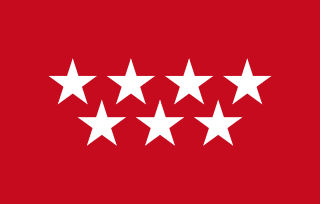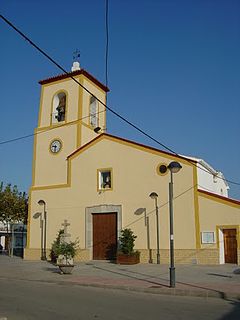
The Community of Madrid is one of the seventeen autonomous communities of Spain. It is located in the centre of the Iberian Peninsula, and of the Central Plateau . Its capital and largest municipality is Madrid, which is also the capital of the country. The Community of Madrid is bounded to the south and east by Castilla–La Mancha and to the north and west by Castile and León. It was formally created in 1983, based on the limits of the province of Madrid, which was until then conventionally included in the historical region of New Castile.

Alcalá de Henares is a Spanish city in the Community of Madrid. Straddling the Henares River, it is located 35 kilometres to the northeast of the centre of Madrid. As of 2018, it has a population of 193,751, making it the region's third-most populated municipality.

Utrera is a municipality in south-west Spain. It is in the province of Seville, in the autonomous community of Andalusia. As of 2018 it has a population of 52,617.

The University of Alcalá is a public university located in Alcalá de Henares, a city 35 km northeast of Madrid in Spain and also the third-largest city of the region. It was founded in 1293 as a Studium Generale for the public, and was refounded in 1977. The University of Alcalá is especially renowned in the Spanish-speaking world for its annual presentation of the highly prestigious Cervantes Prize. The university currently enrolls 28,336 students, 17,252 of whom are studying undergraduate degrees which are taught by a teaching staff of 2,608 professors, lecturers and researchers belonging to 24 departments. The administrative tasks is carried out by the Administration and Services, comprising approximately 800 people.

Totana is a municipality in the Region of Murcia in Spain. It has a population of 32008. The local economy is largely dependent on agriculture and related industries. It has a railway station providing a service on the Cercanías Murcia/Alicante commuter line, providing connections to Alicante and Murcia.

Isidore the Farm Labourer, also known as Isidore the Farmer, was a Spanish farmworker known for his piety toward the poor and animals. He is the Catholic patron saint of farmers and of Madrid, El Gobernador, Jalisco and of La Ceiba, Honduras. His feast day is celebrated on May 15.
Neo-Mudéjar is a type of Moorish Revival architecture practised in the Iberian Peninsula and to a far lesser extent in Ibero-America. This architectural movement emerged as a revival of Mudéjar style. It was an architectural trend of the late 19th and early 20th centuries that began in Madrid and Barcelona and quickly spread to other regions in Spain and Portugal. It used Mudéjar style elements such as the horseshoe arch, arabesque tiling, and abstract shaped brick ornamentations for the façades of modern buildings.

Simat de la Valldigna is a municipality in the comarca of Safor in the Valencian Community, Spain. It is 50 km from Valencia, and 20 km from Cullera and Gandia. It is also near Xàtiva and Alzira.

Azuqueca de Henares is a municipality located in the province of Guadalajara, Castile-La Mancha, Spain. According to the 2013 census (INE), the municipality had a population of 34.685 inhabitants. The mayor of Azuqueca is José Luis Blanco.
Laguna de Duero is a municipality located in the province of Valladolid, Castile and León, Spain. According to the 2016 census (INE), the municipality has a population of 22 ,696 inhabitants.
Meco is a municipality in the eastern part of the Autonomous Community of Madrid, (Spain). In 2006, Meco had a population of 11,094.

Fuente Álamo de Murcia is a town and municipality in the Region of Murcia, southern Spain. It is situated 22 km northwest of Cartagena and 35 km south west of Murcia. The town lies in the basin of the Mar Menor surrounded by the mountains of Algarrobo, Los Gómez, Los Victorias and the Carrascoy.

Torre-Pacheco is a municipality in the autonomous community of Murcia in southeastern Spain. It covers an area of 189.4 km² and its population in 2019 was 35,676. The only high ground in the municipality is Cabezo Gordo hill, the location of the protected Sima de las Palomas archeological site. The town has one secondary education institution, the I.E.S. Gerardo Molina.

Ajalvir is a town and municipality in the Autonomous Community of Madrid in central Spain, located 26 kilometres (16 mi) north-east of Madrid and 12 kilometres (7.5 mi) from Alcalá de Henares. It is located in the comarca of Alcalá.

Ambite is a municipality in the province of Madrid in central Spain. It belongs to the comarca of Alcalá. It has 382 inhabitants in an area of 26 square kilometres (10 sq mi), with a population density of 14.69 hab/km2. It lies 770 metres (2,530 ft) above sea level.

The Fiesta de las Cruces or Cruz de Mayo is a holiday celebrated on 3 May in many parts of Spain and Hispanic America.

The Feria de Agosto or Feria de Málaga takes place every August in the city of Málaga, Andalusia, Spain.

Miguel de Cervantes Health Care Centre is a building located at Alcalá de Henares, which belongs to the Health Service of Madrid and it is assigned to direct public health care attention.
















